
Genesis, an English rock band formed in 1967 at Charterhouse School, Surrey, saw its most successful lineup with Tony Banks, Mike Rutherford, and Phil Collins. The band was a pioneer in progressive rock during the 1970s, including members Peter Gabriel and Steve Hackett at the time. They transitioned towards pop in the following decades, releasing hits and achieving massive commercial success worldwide. Collins took over as lead vocalist after Gabriel’s departure, marking a new era of success. The band underwent several lineup changes and continued to evolve musically, releasing a total of 15 studio albums and selling between 100 million and 150 million albums globally.
They received numerous awards and were inducted into the Rock and Roll Hall of Fame in 2010. After Collins left in 1996, Ray Wilson joined as the lead singer for the album “Calling All Stations”, but it failed to match previous successes, leading to a hiatus. Genesis reunited for tours in 2007 and again in 2021 with Collins, Banks, and Rutherford for “The Last Domino?” tour, indicating it might be their final act due to Phil Collins‘ health issues. In 2022, Genesis sold a portion of their music rights to Concord for an estimated £270 million, showcasing their lasting impact on the music industry.
1969 – From Genesis to Revelation

Side one
1/ Where the Sour Turns to Sweet – 3:14
2/ In the Beginning – 3:42
3/ Fireside Song – 4:16
4/ The Serpent – 4:36
5/ Am I Very Wrong? – 3:28
6/ In the Wilderness – 3:21
Side two
1/ The Conqueror – 3:44
2/ In Hiding – 2:56
3/ One Day – 3:16
4/ Window – 3:53
5/ In Limbo – 3:06
6/ The Silent Sun – 2:08
7/ A Place to Call My Own – 1:57
“From Genesis to Revelation” is the debut studio album by the English rock band Genesis, released on March 28, 1969, by Decca Records. It emerged from demos made in 1967 when the band members were students at Charterhouse School. The demos caught Jonathan King’s attention, who helped the band secure deals and studio time, leading to the album’s recording with added string sections on some tracks. Despite the commercial failure and mixed reviews, the album marked the beginning of Genesis, featuring singles like “The Silent Sun” and “A Winter’s Tale”.
After a brief hiatus and reformation, the band pursued music full-time, distancing from King and transitioning towards their iconic sound. The album, reflecting early pop music ambitions, was reissued several times, highlighting its historical significance despite initial poor sales and reception.
Credits
Peter Gabriel – lead vocals, flute / Tony Banks – Hammond organ, piano, backing vocals / Anthony Phillips – guitars, backing vocals / Mike Rutherford – bass guitar, guitar, backing vocals / John Silver – drums (except on “Silent Sun”) Additional musicians Chris Stewart – drums on “Silent Sun” / Arthur Greenslade – strings and horn arrangement, conducting / Lou Warburton – strings and horn arrangement, conductingBuy Genesis album on Amazon: Genesis album – From Genesis to Revelation
1970 – Trespass

1/ Looking for Someone – 7:06
2/ White Mountain – 6:44
3/ Visions of Angels – 6:52
Side two
1/ Stagnation – 8:51
2/ Dusk – 4:13
3/ The Knife – 8:56
“Trespass” is the second studio album by the English rock band Genesis, released on October 23, 1970. It marks the final contribution of original guitarist Anthony Phillips and the only appearance of drummer John Mayhew. This album showcases the band’s transition from pop to a more folk-flavored progressive rock, highlighted by acoustic pieces and the heavier “The Knife.” The album’s cover, designed by Paul Whitehead, features a knife slash, reflecting a shift in the band’s musical direction.
Genesis decided to go professional in late 1969, securing a contract with Charisma Records after intensive touring and live performances. The recording of “Trespass” at Trident Studios in London was a departure from their previous work, moving towards more complex and diverse musical styles. Despite the lack of immediate commercial success in the UK and the US, the album found an audience in Belgium, aiding the band’s continued career.
Phillips’ departure shortly after recording due to stage fright and dissatisfaction with the band’s direction nearly led to Genesis disbanding. However, they decided to continue, replacing Mayhew with Phil Collins. Over time, “Trespass” gained recognition, especially after a reissue in 1984 briefly charted in the UK. The album’s development, marked by changes in band membership and musical style, laid the groundwork for Genesis‘s evolution into a major progressive rock act.
Credits
Peter Gabriel – lead vocals, flute, accordion, tambourine, bass drum / Anthony Phillips – acoustic 12-string guitar, lead electric guitar, dulcimer, vocals / Tony Banks – Hammond organ, grand piano, Mellotron, acoustic 12-string guitar, vocals / Mike Rutherford – acoustic 12-string guitar, electric bass guitar, classical guitar, cello, vocals / John Mayhew – drums, percussion, vocalsBuy Genesis album on Amazon: Genesis album – Trespass
1971 – Nursery Cryme
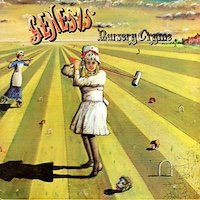
“Nursery Cryme”, the third studio album by Genesis, released on November 12, 1971, marked the first appearance of drummer/vocalist Phil Collins and guitarist Steve Hackett. Despite a mixed critical reception and initial commercial struggles in the UK (not charting until 1974), the album found success in Continental Europe, especially Italy. The album is noted for its aggressive musical direction in some songs, significant contributions from Collins and Hackett, and a mix of twelve-string guitars with harsh electric guitars and keyboards. It features “The Musical Box”, a live favorite, and other tracks that highlight the band’s evolving sound, including Collins‘s first lead vocal on “For Absent Friends” and Hackett’s suggestion to use the Mellotron more prominently. Genesis extensively toured to promote “Nursery Cryme”, helping to raise their profile. The album eventually achieved Silver certification in the UK in 2013.
Following guitarist Anthony Phillips’s departure due to stress and unhappiness from touring, Genesis nearly split but decided to continue, ultimately recruiting Collins and Hackett. This lineup change allowed the band to explore new sounds and musical ideas, leading to the creation of “Nursery Cryme” after dedicated rehearsal time. The album’s recording at Trident Studios in London produced songs like “The Musical Box” and “The Return of the Giant Hogweed”, featuring innovative guitar techniques and storytelling lyrics. Despite the production challenges and initial indifference from their record company, “Nursery Cryme” played a significant role in Genesis‘s growth and development as a band, establishing a foundation for their future successes.
Credits
Tony Banks – Hammond organ, Mellotron, piano, electric piano, 12-string guitar, backing vocals / Mike Rutherford – bass, bass pedals, 12-string guitar, backing vocals / Peter Gabriel – lead voice, flute, oboe, bass drum, tambourine / Steve Hackett – electric guitar, 12-string guitar / Phil Collins – drums, voices, percussion, lead vocals on “For Absent Friends”, co-lead vocals on “Harold the Barrel” and “Harlequin”Buy Genesis album on Amazon: Genesis album – Nursery Crime
1972 – Foxtrot

Side one
1/ Watcher of the Skies – 7:24
2/ Time Table – 4:47
3/ Get ‘Em Out by Friday – 8:38
4/ Can-Utility and the Coastliners – 5:48
Side two
1/ Horizons – 1:42
2/ Supper’s Ready
a. Lover’s Leap
b. The Guaranteed Eternal Sanctuary Man
c. Ikhnaton and Itsacon and Their Band of Merry Men
d. How Dare I Be So Beautiful?
e. Willow Farm
f. Apocalypse in 9/8
g. As Sure as Eggs Is Eggs (Aching Men’s Feet) – 22:54
“Foxtrot”, released on September 15, 1972, is the fourth studio album by English progressive rock band Genesis, notable for featuring their longest track, the 23-minute “Supper’s Ready”. The album emerged post the tour of their prior album “Nursery Cryme”, contributing to their rising popularity. Written during the summer of 1972, “Foxtrot” combines previously live-performed songs with new jams. Recording saw tension and producer changes, initially starting with John Anthony and concluding with Dave Hitchcock. The album’s cover, a fox in a red dress, inspired Peter Gabriel‘s stage attire, enhancing press attention and the band’s profile.
“Foxtrot” marked Genesis‘s first chart appearance in the UK, reaching No. 12 and enjoying critical acclaim, especially in Italy where it hit No. 1. The album, praised for its composition and thematic depth, includes the tracks “Watcher of the Skies” and the epic “Supper’s Ready”, reflecting on themes from sci-fi to historical and mythical narratives. Despite initial disagreements on production, “Foxtrot” was seen by the band, especially Tony Banks, as a significant work without weak tracks, receiving a positive reception from Charisma Records owner Tony Stratton Smith. The album’s creative process was marked by experimentation and a collaborative spirit, laying a foundation for the band’s future endeavors and solidifying its place in progressive rock history. It has been reissued in a box set with new mixes, maintaining its critical praise over the years.
Credits
Tony Banks – Hammond organ, Mellotron, electric and acoustic pianos, 12-string guitar, backing vocals / Steve Hackett – electric guitar, 6-string guitar, 12-string guitar / Phil Collins – drums, backing vocals, assorted percussion / Peter Gabriel – lead vocals, flute, bass drum, tambourine, oboe / Mike Rutherford – bass guitar, bass pedals, cello, 12-string guitar, backing vocalsBuy genesis album on Amazon: Genesis album – Foxtrot
1973 – Selling England by the Pound

1/ Dancing with the Moonlit Knight – 8:05
2/ I Know What I Like (In Your Wardrobe) – 4:08
3/ Firth of Fifth – 9:38
4/ More Fool Me – 3:12
Side two
1/ The Battle of Epping Forest – 11:49
2/ After the Ordeal – 4:17
3/ The Cinema Show – 11:06
4/ Aisle of Plenty – 1:33
“Selling England by the Pound”, Genesis‘s fifth studio album, was released on September 28, 1973. It peaked at No. 3 in the UK and No. 70 in the US, with the single “I Know What I Like (In Your Wardrobe)” becoming their first UK top 30 hit in February 1974. The album, recorded in August 1973 after their North American tour, reflects themes of lost English folk culture and the impact of Americanization, encapsulated in the album’s title. Despite mixed initial reviews, its reputation has grown over time, earning critical acclaim and featuring in rankings of top progressive rock albums. It achieved Gold certification in both the UK and the US.
The background to the album involves the band’s touring success and pressure from Charisma Records for quick new releases. After the tour, the band took time to write and rehearse new material, with sessions taking place in various locations, including a stately home in Chessington and a rehearsal space in Shepherd’s Bush, London. The album’s writing and recording were marked by a mix of creative jam sessions and moments of tension, particularly influenced by the band’s exploration of “Englishness” and critiques of American cultural influence.
The album opens with “Dancing with the Moonlit Knight”, touching on themes of English identity, followed by “I Know What I Like (In Your Wardrobe)”, which emerged from a jam session and became the band’s first charting single. “Firth of Fifth”, largely written by Tony Banks, showcases complex arrangements and a memorable guitar solo by Steve Hackett. “More Fool Me” features Phil Collins on lead vocals, presenting a softer, more romantic ballad. “The Battle of Epping Forest”, inspired by East End gang wars, and “After the Ordeal,” an instrumental track, demonstrate the album’s diverse musical and thematic range. “The Cinema Show” divides into a guitar-based piece and a keyboard solo, with lyrics drawing from T.S. Eliot’s “The Waste Land”. The album concludes with “Aisle of Plenty”, a lyrical callback to the album’s opening track, completing the thematic circle.
“Selling England by the Pound” stands as a pivotal work in Genesis‘s discography, notable for its lyrical depth, musical complexity, and exploration of cultural themes, solidifying the band’s legacy in progressive rock.
Credits
Peter Gabriel – vocals, flute, oboe, percussion / Tony Banks – Hammond organ, Mellotron, Hohner Pianet, ARP Pro Soloist, piano, 12-string guitar / Steve Hackett – electric guitar, nylon guitar Mike Rutherford – 12-string guitar, bass, electric sitar, cello / Phil Collins – drums, assorted percussion, lead vocals on “More Fool Me”, backing vocalsBuy Genesis album on Amazon: Genesis album – Selling England by The Pound
1974 – The Lamb Lies Down on Broadway

1/ The Lamb Lies Down on Broadway – 4:48
2/ Fly on a Windshield – 2:45
3/ Broadway Melody of 1974 – 2:11
4/ Cuckoo Cocoon – 2:11
5/ In the Cage – 8:14
6/ The Grand Parade of Lifeless Packaging – 2:47
Side two
1/ Back in N.Y.C. – 5:44
2/ Hairless Heart – 2:10
3/ Counting Out Time – 3:42
4/ Carpet Crawlers – 5:15
5/ The Chamber of 32 Doors – 5:40
Side three
1/ Lilywhite Lilith – 2:45
2/ The Waiting Room – 5:22
3/ Anyway – 3:08
4/ Here Comes the Supernatural Anaesthetist – 3:00
5/ The Lamia – 6:57
6/ Silent Sorrow in Empty Boats – 3:07
Side four
1/ The Colony of Slippermen
a. The Arrival
b. A Visit to the Doktor
c. The Raven – 8:13
2/ Ravine – 2:04
3/ The Light Dies Down on Broadway – 3:33
4/ Riding the Scree – 3:57
5/ In the Rapids – 2:30
6/ it. – 4:14
“The Lamb Lies Down on Broadway”, released on November 22, 1974, is Genesis‘s sixth studio album and the last featuring Peter Gabriel as the frontman. This double album, reaching No. 10 in the UK and No. 41 in the US, is known for its concept story devised by Gabriel, following Rael, a Puerto Rican youth from New York City, on a surreal journey of self-discovery. The album’s creation at Headley Grange was marred by tensions, especially due to Gabriel‘s insistence on writing all the lyrics and his temporary departure to work with filmmaker William Friedkin. Despite initial mixed reviews, the album later gained acclaim and a cult following, with singles “Counting Out Time” and “The Carpet Crawlers” being released in the UK. Genesis promoted the album with a tour, performing it in its entirety. The album, certified Gold in the UK and US, was remastered in 1994 and 2007.
The band, after their successful tour for “Selling England by the Pound”, gathered at Headley Grange to write new material, facing personal challenges and band friction, particularly with Gabriel‘s seclusion for lyrics writing. Inspired by various sources, including “West Side Story” and the film “El Topo”, Peter Gabriel crafted a story filled with American imagery, contrasting with the English themes of their previous album. Despite Gabriel’s focus on lyrics causing a divide, the band developed music through jam sessions.
Recording moved to Glaspant Manor in Wales, using a mobile studio, with Gabriel recording additional vocals in London. The story, featuring diverse themes from mythology to consumerism, follows Rael’s encounters with bizarre characters and situations, reflecting Gabriel‘s dreams and concerns with identity and culture. Each song contributes to the narrative, from Rael’s initial sighting of a lamb in New York to his transformative journey, concluding with ambiguous self-discovery.
“The Lamb Lies Down on Broadway” remains a significant work in Genesis‘s discography, showcasing their willingness to explore complex narratives and experiment musically, despite the challenges during its production. Peter Gabriel‘s departure from the band following this album marked the end of an era and the beginning of a new chapter for Genesis.
Credits
Peter Gabriel – lead vocals, flute, varied instruments, “experiments with foreign sounds” / Steve Hackett – acoustic and electric guitars /Mike Rutherford – bass guitar, 12-string guitar / Tony Banks – Hammond T-102 organ, RMI 368 Electra Piano and Harpsichord, Mellotron M-400, ARP Pro Soloist synthesizer, Elka Rhapsody string synthesizer, acoustic piano / Phil Collins – drums, percussion, vibraphone, backing vocals, second lead vocal on “Counting out Time”, “The Supernatural Anaesthetist” and “The Colony of Slippermen”
Additional musician
Brian Eno – “Enossification” on “In the Cage” and “The Grand Parade of Lifeless Packaging”
Buy Genesis album on Amazon: Genesis album – The Lamb Lies Down on Broadway
1976 – A Trick of the Tail
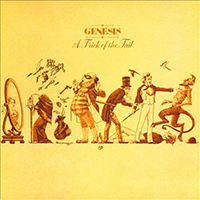
1/ Dance on a Volcano – 5:56 Drum sheet – Drum sheet easy
2/ Entangled – 6:27
3/ Squonk – 6:30 – Drum sheet
4/ Mad Man Moon – 7:34
Side two
1/ Robbery, Assault and Battery – 6:17
2/ Ripples… – 8:07 – Drum sheet
3/ A Trick of the Tail – 4:35
4/ Los Endos – 5:48
“A Trick of the Tail“, Genesis‘s seventh studio album, released on February 13, 1976, marked a pivotal moment as the first album featuring Phil Collins as the lead vocalist following Peter Gabriel‘s departure. Achieving critical and commercial success, the album reached No. 3 in the UK and No. 31 in the U.S. Despite uncertainties surrounding Gabriel‘s exit, the remaining members, notably Tony Banks and Mike Rutherford, Genesis‘s primary music writers, continued the band’s legacy by contributing new songs. The band ventured into Trident Studios in October 1975 with producer David Hentschel, embarking on recording without a confirmed lead vocalist. After an exhaustive search for Gabriel‘s replacement yielded no fruitful results, Collins stepped up to sing “Squonk“, impressing the band enough to take on lead vocals for the entire album.
The recording process highlighted the band’s resolve and adaptation, with Collins balancing his roles as drummer and vocalist, signaling a new era for Genesis. The album featured tracks like “Dance on a Volcano” and “Squonk“, inspired by the mythical creature, showcasing the band’s continued penchant for blending intricate musical compositions with fantastical and narrative-driven lyrics. “Robbery, Assault and Battery” continued the band’s tradition of storytelling through music, while “Ripples…” and the title track, “A Trick of the Tail“, demonstrated the band’s lyrical depth and musical innovation.
Upon its release, “A Trick of the Tail” received positive reviews, with critics particularly noting the band’s seamless transition post-Gabriel and the improved sound quality under Hentschel’s production. The album’s success dispelled doubts about Genesis‘s viability without Peter Gabriel, reaffirming the band’s cohesion and creative strength. It was certified Gold in both the UK and the U.S., a testament to its enduring appeal and the band’s resilience. Genesis supported the album with a tour, featuring Collins as the frontman and Bill Bruford as the tour drummer, which elevated their profile in the U.S. and solidified Collins‘s role as the band’s new lead vocalist.
“A Trick of the Tail” stands as a testament to Genesis‘s adaptability and collaborative spirit, marking a successful new chapter in the band’s history without compromising the quality and integrity of their music.
Credits
Phil Collins – drums, percussion, lead and backing vocals / Steve Hackett – electric guitar, 12-string guitars / Mike Rutherford – bass guitar, bass pedals, 12-string guitar, backing vocals / Tony Banks – pianos, synthesizers, Hammond organ, Mellotron, 12-string guitar, backing vocalsBuy Genesis album on Amazon: Genesis album – A Trick of the Tail
1976 – Wind & Wuthering

Side one
1/ Eleventh Earl of Mar – 7:46
2/ One for the Vine – 10:01
3/ Your Own Special Way – 6:19
4/ Wot Gorilla? – 3:23
Side two
1/ All in a Mouse’s Night – 6:40
2/ Blood on the Rooftops – 5:29
3/ Unquiet Slumbers for the Sleepers… – 2:24
4/ …In That Quiet Earth – 4:50
5/ Afterglow – 4:11
“Wind & Wuthering”, Genesis‘s eighth studio album released on December 17, 1976, was their last to feature guitarist Steve Hackett. Following their successful 1976 tour, the band recorded the album in the Netherlands, marking their first project outside the UK. This period saw internal tensions, particularly with Hackett feeling his contributions were overlooked in favor of keyboardist Tony Banks’s material. Despite these challenges, the album received positive reviews and bolstered Genesis‘s growing popularity in the US, achieving Gold certification in both the UK and US. The single “Your Own Special Way” became their first to chart in the US. The 1977 tour would be Hackett’s last with Genesis, introducing Chester Thompson as their live drummer.
Recording took place at Relight Studios in Hilvarenbeek, prompted by the financial benefit of recording abroad and facilitated by producer David Hentschel. Despite its successful reception and contributions to the band’s discography, “Wind & Wuthering” represented a period of transition, particularly highlighted by Hackett’s eventual departure due to creative differences.
The album title, suggested by Banks, drew from its atmospheric and thematic elements, reminiscent of Emily Brontë’s “Wuthering Heights”, with the album cover reflecting this inspiration. Songs like “Eleventh Earl of Mar” and “One for the Vine” continued Genesis‘s tradition of complex compositions and storytelling, while “Your Own Special Way” offered a more accessible, pop-oriented sound. “All in a Mouse’s Night” and “Blood on the Rooftops” showcased the band’s range from whimsical narratives to more introspective themes.
Critically, “Wind & Wuthering” was lauded for its ambition and musicality, maintaining Genesis‘s stature in progressive rock despite the lineup changes. The album’s legacy is affirmed by its positive critical reevaluation and the lasting impact on Genesis‘s sound and evolution as a band.
Credits
Phil Collins – vocals, drums, cymbals, percussion / Steve Hackett – electric guitars, nylon classical guitar, 12 string guitar, kalimba, autoharp / Mike Rutherford – 4, 6, and 8 string bass guitars, electric and 12 string acoustic guitars, bass pedals, backing vocals / Tony Banks – Steinway grand piano, ARP 2600 synthesizer, ARP Pro Soloist synthesizer, Hammond organ, Mellotron, Roland RS-202 string synthesizer, Fender Rhodes electric piano, 12 string guitar, backing vocalsBuy Genesis album on Amazon: Genesis album – Wind & Wuthering
1978 – …And Then There Were Three…
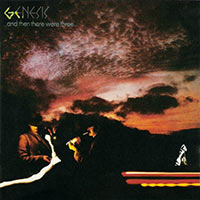
Side one
1/ Down and Out – 5:28
2/ Undertow – 4:47 – Drum sheet
3/ Ballad of Big – 4:51
4/ Snowbound – 4:31 – Drum sheet
5/ Burning Rope – 7:10
Side two
1/ Deep in the Motherlode – 5:16
2/ Many Too Many – 3:32 – Drum sheet
3/ Scenes from a Night’s Dream – 3:30
4/ Say It’s Alright Joe – 4:21
5/ The Lady Lies – 6:08 – Drum sheet
6/ Follow You Follow Me – 4:01
“…And Then There Were Three…” is Genesis‘s ninth studio album, released on March 31, 1978, marking their transition to a trio comprising Phil Collins, Tony Banks, and Mike Rutherford after Steve Hackett’s departure. This shift heralded a change in their music from progressive rock to a more accessible sound, with a greater input from Collins in songwriting. Despite mixed reviews, the album achieved significant commercial success, reaching No. 3 in the UK and No. 14 in the US, with the single “Follow You Follow Me” hitting new chart highs for the band. The album went platinum in the US, and the supporting world tour introduced live musicians Daryl Stuermer and Chester Thompson, who would remain with Genesis for decades.
Recorded in the Netherlands and London, the album’s production saw the band working closely with audio engineer and co-producer David Hentschel, with Rutherford taking on lead guitar duties. The writing process was dominated by Banks and Rutherford, moving away from extended jams to more structured, concise songs, a decision influenced by the contemporary music scene. The album’s artwork, designed by Hipgnosis, aimed to visually represent the themes and transitions within the band.
Critics praised the album for its confident sound and noted it as a strong continuation post-Hackett, with particular songs like “Down and Out” and “Ballad of Big” being highlighted. However, some reviews criticized the album for its lack of distinctiveness and compared it unfavorably to Genesis‘s earlier work. Over the years, “…And Then There Were Three…” has been re-evaluated in various retrospectives, with opinions remaining divided on its place within the Genesis discography, balancing its commercial breakthrough against artistic shifts.
Credits
Tony Banks – keyboards / Phil Collins – drums, vocals / Mike Rutherford – basses, guitarsBuy Genesis album on Amazon: Genesis album – And Then There Were three
1980 – Duke

Side one
1/ Behind the Lines – 5:31
2/ Duchess – 6:40
3/ Guide Vocal – 1:18
4/ Man of Our Times – 5:35
5/ Misunderstanding – 3:11
6/ Heathaze – 5:00
Side two
1/ Turn It On Again – 3:50 – Drum sheet
2/ Alone Tonight – 3:54
3/ Cul-de-sac – 5:02
4/ Please Don’t Ask – 4:00 – Drum sheet
5/ Duke’s Travels – 8:41
6/ Duke’s End – 2:04
“Duke” is the tenth studio album by Genesis, released in 1980, marking a pivotal point in the band’s career as they transitioned from progressive rock to a more accessible, pop-rock oriented sound. This shift was largely influenced by Phil Collins‘ personal turmoil, including a move to Vancouver in an attempt to save his marriage, which ultimately failed. This period of upheaval for Collins, alongside solo projects by Tony Banks and Mike Rutherford, led to a rejuvenated band dynamic and a collaborative approach to the album’s creation.
The album was well-received, praised for blending progressive elements, as seen in the “Duke’s Travels”/”Duke’s End” suite, with pop-rock singles like “Turn It On Again“, “Duchess”, and “Misunderstanding”. It reached No. 1 in the UK, a first for Genesis, and was certified Platinum in the UK and the US.
The background to “Duke” involved significant personal and professional changes for the band members, including Collins‘ divorce and the band’s decision to proceed as a trio after Steve Hackett’s departure. Despite these challenges, the band found recording “Duke” to be a relatively smooth process, benefiting from a break in their usual routine and the influx of new material, particularly from Collins. This material, some of which was deeply personal and reflective of Collins‘ divorce, contributed to both “Duke” and his solo album “Face Value“.
“Duke” represented a stylistic shift for Genesis, incorporating more concise songwriting and pop elements while still retaining the band’s signature complexity and depth. This balance between progressive rock and pop accessibility would define Genesis‘s sound in the 1980s. The album’s artwork, inspired by French illustrator Lionel Koechlin, and its thematic “Duke Suite”, further showcased the band’s creative evolution.
Upon its release, “Duke” was a commercial success, signaling Genesis‘s emergence as a major pop-rock act. The album’s singles, particularly “Turn It On Again” and “Misunderstanding”, received considerable radio play, expanding the band’s audience. Critical reception was generally positive, with praise for the album’s dynamic range and the successful integration of progressive and pop elements.
In summary, “Duke” stands as a landmark album in Genesis‘s discography, marking a successful transition into a new era for the band both musically and commercially, fueled by personal experiences and a collaborative spirit.
Credits
Tony Banks – keyboards, backing vocals, 12-string guitar, duck / Mike Rutherford – guitars, bass guitar, bass pedals, backing vocals / Phil Collins – lead vocals, drums, drum machine, percussion, duckBuy Genesis album on Amazon: Genesis album – Duke
1981 – Abacab
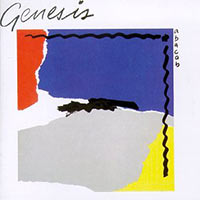
Side one
1/ Abacab – 6:58 – Drum sheet
2/ No Reply at All – 4:33
3/ Me and Sarah Jane – 6:02 – Drum sheet
4/ Keep It Dark – 4:33 – Drum sheet
Side two
1/ Dodo/Lurker – 5:09/2:19 – Drum sheet
2/ Who Dunnit? – 3:22
3/ Man on the Corner – 4:28
4/ Like It or Not – 4:58 – Drum sheet
5/ Another Record – 4:38 – Drum sheet
“Abacab“, Genesis‘s eleventh studio album, released in 1981, marks a pivotal point in the band’s transition from progressive rock to a more pop-oriented sound. Recorded at The Farm, their new studio in Surrey, this project was the band’s first without former members Peter Gabriel and Steve Hackett, emphasizing a trio format. The album was well-received, hitting No. 1 in the UK and breaking into the top ten in the US, showcasing singles like “Abacab” and “No Reply at All”.
The creation of “Abacab” followed a period of rest and solo projects by band members Phil Collins, Tony Banks, and Mike Rutherford. The album’s direction was a conscious effort to deviate from Genesis‘s previous work, focusing on simpler, more accessible music and avoiding the band’s traditional extended solos and intricate instrumentals. This change was influenced partly by Collins‘s solo success with “Face Value” and the desire to innovate and avoid becoming a parody of their past selves.
Recording “Abacab” at The Farm allowed Genesis to explore new songwriting approaches, including group improvisations and the use of electronics, like drum machines. The departure of longtime producer David Hentschel for engineer Hugh Padgham also brought a fresh perspective, particularly in the drum sound, inspired by Phil Collins‘s work with Peter Gabriel.
Critically, “Abacab” was seen as a step forward for Genesis, mixing the old with the new and effectively bringing the band’s music into the 1980s. While some reviews critiqued the album for its unevenness and departure from Genesis‘s prog roots, others praised its innovation and the more prominent role of Collins‘s drums. The album’s reception highlighted Genesis‘s successful adaptation to the changing musical landscape, blending their art rock heritage with contemporary pop sensibilities.
Credits
Tony Banks – keyboards / Phil Collins – drums, vocals / Mike Rutherford – guitars, bassesAdditional musicians
EWF Horns – horns on “No Reply at All” / Thomas “Tom Tom 84” Washington – horn arrangements on “No Reply at All”
Buy Genesis album on Amazon: Genesis album – Abacab
1983 – Genesis

Side one
1/ Mama – 6:52 – Drum sheet – Drum cover
2/ That’s All – 4:25
3/ Home by the Sea – 5:08 – Drum sheet – Free drum lesson
4/ Second Home by the Sea – 6:06 – Drum sheet
Side two
1/ Illegal Alien – 5:17
2/ Taking It All Too Hard – 3:58
3/ Just a Job to Do – 4:47
4/ Silver Rainbow – 4:31
5/ It’s Gonna Get Better – 5:14
“Genesis“, the twelfth studio album by the English rock band of the same name, was released in 1983 and marked a significant moment in the band’s evolution towards a more accessible pop-rock sound. Recorded after an eight-month hiatus, this was the first album the band wrote and recorded entirely at their newly established studio, The Farm, in Surrey. The album’s creation process was characterized by a more collaborative approach, with songs developed through jam sessions, a departure from their previous method of working on pre-arranged ideas. This change was partly facilitated by the relaxed environment of their private studio and the return of engineer Hugh Padgham, who also took on production duties.
“Genesis” achieved remarkable commercial success, reaching No. 1 in the UK and No. 9 in the US, and saw the release of five singles, including the UK hit “Mama” and the US top 10 hit “That’s All”. The album’s success was accompanied by a tour, with highlights forming the concert video “Genesis Live: The Mama Tour”. It received a Grammy nomination in 1985 and was re-released with new mixes in 2007.
The album’s development was influenced by the band’s solo projects during their break and represented a conscious effort to move away from their progressive rock roots. This shift was also reflected in the decision to credit the entire band for songwriting, emphasizing the collaborative nature of the album’s creation. The use of modern keyboards and electronic drums contributed to the album’s more contemporary sound, with tracks ranging from the aggressive “Mama” to the catchy “That’s All” and the storytelling “Home by the Sea“.
Critical reception was mixed, with some praising the band’s successful reinvention into a pop group and others criticizing the lack of coherence across the album. Despite this, “Genesis” remains a landmark in the band’s discography, symbolizing their transition into pop-rock and broadening their appeal to a larger audience.
Credits
Mike Rutherford – guitars, bass, backing vocals / Phil Collins – drums, vocals, percussion / Tony Banks – keyboards, backing vocals
Buy Genesis album on Amazon: Genesis album – Genesis
1986 – Invisible Touch
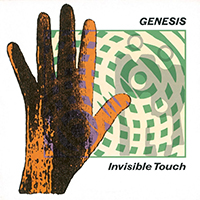
Side one
1/ Invisible Touch – 3:29 – Drum sheet – Drum cover
2/ Tonight, Tonight, Tonight – 8:53 – Drum sheet
3/ Land of Confusion – 4:45 – Drum sheet
4/ In Too Deep – 4:58
Side two
1/ Anything She Does – 4:09
2/ Domino :
I. In the Glow of the Night – 4:27
II. The Last Domino – 6:18
3/ Throwing It All Away – 3:53
4/ The Brazilian – 4:50
“Invisible Touch“, Genesis‘s thirteenth studio album, was released in 1986 following a brief hiatus for solo projects. Reuniting with producer Hugh Padgham, the album was crafted through group improvisations at The Farm, their studio in Surrey. Achieving widespread success, it soared to No. 1 in the UK and No. 3 in the US, becoming their best-selling album with over 6 million copies sold in the US alone. It distinguished itself by having five top-five singles in the US, a first for the band, with the title track hitting No. 1.
The album’s creation marked a continuation of the collaborative writing process initiated with their previous work, “Genesis“, focusing on jams and improvisations without prior material. This approach, combined with the use of modern electronic drums and keyboards, led to a pop-oriented sound that resonated widely but also drew mixed reviews for its similarity to Phil Collins‘s solo work and its departure from the band’s progressive roots.
“Invisible Touch” is notable for hits like “Land of Confusion” and “In Too Deep”, showcasing the band’s ability to blend pop sensibilities with their established art rock foundation. Despite criticisms of it being too aligned with Collins‘s solo style, it received accolades for its hook-laden tracks and production quality. Over time, it has been reassessed, with some viewing it as a pivotal, albeit polarizing, album in Genesis‘s discography, symbolizing their complete shift to mainstream pop music.
Credits
Tony Banks – keyboards, synth bass / Phil Collins – drums, percussion, vocals / Mike Rutherford – guitars, bass
Buy Genesis album on Amazon: Genesis album – Invisible Touch
1991 – We Can’t Dance

Side one
1/ No Son of Mine – 6:41 – Drum sheet
2/ Jesus He Knows Me – 4:23
3/ Driving the Last Spike – 10:10
Side two
1/ I Can’t Dance – 4:04
2/ Never a Time – 3:52
3/ Dreaming While You Sleep – 7:21
Side three
1/ Tell Me Why – 5:00
2/ Living Forever – 5:42
3/ Hold on My Heart – 4:40
Side four
1/ Way of the World – 5:40
2/ Since I Lost You – 4:10
3/ Fading Lights – 10:16 – Drum sheet
“We Can’t Dance“, Genesis‘s fourteenth studio album and the last with Phil Collins as a member, was released in November 1991. Following a hiatus, during which members pursued solo projects, Genesis reconvened to create this album, which became a worldwide success. It topped the UK charts and reached No. 4 in the US, selling over 4 million copies there. The album features six singles, including “No Son of Mine” and “I Can’t Dance”, with the latter earning a Grammy nomination. A tour in support of the album took place in 1992.
Recorded at their studio, The Farm, in Surrey, the album’s creation was marked by a return to group improvisations with no preconceived material. This approach was preferred by Collins, contributing to his decision to stay with the band. A departure from their previous work with producer Hugh Padgham, the band chose Nick Davis as co-producer and engineer, aiming for a sound that featured Mike Rutherford’s guitar more prominently.
Lyrically, “We Can’t Dance” balances serious topics, like domestic abuse in “No Son of Mine” and the dangers faced by 19th-century railway workers in “Driving the Last Spike”, with lighter, more humorous tracks like “I Can’t Dance”. The band also ventured into social commentary with songs like “Tell Me Why”, addressing the aftermath of the Gulf War.
Despite its commercial success, reviews were mixed, with some critics seeing the album as containing moments of excellence but also criticising it for perceived blandness compared to earlier Genesis works. The album led to a successful tour but also represented the end of an era as Collins announced his departure in 1996 to focus on his solo career. “We Can’t Dance” was re-released in 2007, featuring new mixes and included in the Genesis 1983–1998 box set.
Credits
Tony Banks – keyboards / Phil Collins – drums, percussion, vocals, drum machines / Mike Rutherford – guitars, bass guitar
Buy Genesis album on Amazon: Genesis album – We Can”t Dance
1997 – …Calling All Stations…
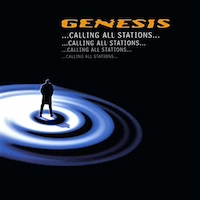
2/ Congo – 4:51
3/ Shipwrecked – 4:23
4/ Alien Afternoon – 7:51
5/ Not About Us – 4:38
6/ If That’s What You Need – 5:12
7/ The Dividing Line – 7:45
8/ Uncertain Weather – 5:29
9/ Small Talk – 5:02
10/ There Must Be Some Other Way – 7:54
11/ One Man’s Fool – 8:58
“…Calling All Stations…” marks the fifteenth and final studio album by Genesis, released in September 1997, featuring Ray Wilson as the lead singer after Phil Collins‘s departure. Despite Wilson’s praised performance, the album received mostly negative reviews for its lack of cohesive direction and did not perform well commercially, especially in the US where it peaked at No. 54. It was more successful in the UK and Europe but did not match the success of previous albums, marking a significant departure from the band’s earlier achievements.
The album was created after a lengthy hiatus, with Tony Banks and Mike Rutherford deciding to continue Genesis despite Collins‘s exit. Wilson, from the grunge band Stiltskin, was chosen as the new frontman after auditions. The recording featured session drummers and was noted for its mix of progressive rock and commercial sounds, though it struggled to find a solid identity.
Key tracks include “Calling All Stations” and “Congo,” with “Small Talk” featuring lyrics written by Wilson. Despite the efforts to rejuvenate the band’s sound, the album’s reception was lukewarm, leading to a European tour but cancelled plans in the US due to low ticket sales. Genesis then focused on archival projects until Collins‘s return for a tour in 2006.
The album’s production was notable for its use of modern recording techniques and the involvement of session drummers Nir Zidkyahu and Nick D’Virgilio. However, despite some positive remarks about certain tracks and Wilson’s fit as a vocalist, critics and even band members reflected on the album’s lack of strong material and overall coherence. Tony Banks later expressed some regret over the album’s uniformity and the omission of potentially strong tracks, while Rutherford acknowledged the changing musical landscape and the band’s shift towards becoming a catalogue act, influencing their decision to cease recording new material.
Credits
Tony Banks – keyboards, acoustic guitar, backing vocals / Mike Rutherford – guitars, bass, backing vocals / Ray Wilson – lead vocals
Additional musicians
Nick D’Virgilio – drums on “Alien Afternoon” (first half), “If That’s What You Need”, “Uncertain Weather”, and “Small Talk”, percussion / Nir Zidkyahu – drums on “Alien Afternoon” (second half) and everything else, percussion
Buy Genesis album on Amazon: Genesis album – Calling all Stations
Find all drum sheet music, drum lessons, and bass tablature here: All the products about Genesis

